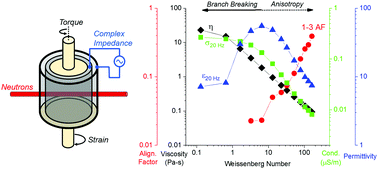Branching and alignment in reverse worm-like micelles studied with simultaneous dielectric spectroscopy and RheoSANS†
Abstract
Topology and branching play an important but poorly understood role in controlling the mechanical and flow properties of worm-like micelles (WLMs). To address the challenge of characterizing branching during flow of WLMs, dielectric spectroscopy, rheology, and small-angle neutron scattering (dielectric RheoSANS) experiments are performed simultaneously to measure the concurrent evolution of conductivity, permittivity, stress, and segmental anisotropy of reverse WLMs under steady-shear flow. Reverse WLMs are microemulsions comprised of the phospholipid surfactant lecithin dispersed in oil with water solubilized in the micelle core. Their electrical properties are independently sensitive to the WLM topology and dynamics. To isolate the effects of branching, dielectric RheoSANS is performed on WLMs in n-decane, which show fast breakage times and exhibit a continuous branching transition for water-to-surfactant ratios above the corresponding maximum in zero-shear viscosity. The unbranched WLMs in n-decane exhibit only subtle decreases in their electrical properties under flow that are driven by chain alignment and structural anisotropy in the plane perpendicular to the electric field and incident neutron beam. These results are in qualitative agreement with additional measurements on a purely linear WLM system in cyclohexane despite differences in breakage kinetics and a stronger tendency for the latter to shear band. In contrast, the branched micelles in n-decane (higher water content) undergo non-monotonic changes in permittivity and more pronounced decreases in conductivity under flow. The combined steady-shear electrical and microstructural measurements are capable, for the first time, of resolving branch breaking at low shear rates prior to alignment-driven anisotropy at higher shear rates.



 Please wait while we load your content...
Please wait while we load your content...
